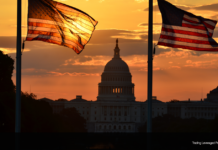What the Fed has done has largely calmed volatile financial markets. A more difficult task awaits, which is to help save an economy and labor market that has collapsed into the worst disaster since the Great Depression.
The Fed will meet on Tuesday and Wednesday against the background of gloomy data. More than 26 million people have applied for unemployment benefits since the coronavirus forced widespread business closures. Retail sales fell with record speed and home sales slumped. Inflation began to fall amid falling economic activity and is certain to sink further below the Fed’s 2% target level. The closure of most hotels, airlines and retailers beleaguered cut prices, and inflation could drop to 1% or less by the end of the year. This is another problem for the Fed, because falling prices can ultimately cause consumers to delay spending, thus slowing down the economy further.
In response, the Fed has cut its benchmark interest rate to near zero in two emergency measures and launched a loan program to pump cash into the market. The central bank has also bought about $1.4 trillion in Treasury securities to ensure that banks can exchange Treasuries for cash and keep interest rates low.
In a later meeting, there is the possibility of the Central Bank providing more details about its loan program and also filling in some specifics about the Treasury purchase program, which is currently unlimited. At a meeting last month the Fed said it would keep interest rates near zero, until the difficult time is over for the US economy.
The Fed also said it would buy up to $750 billion in corporate bonds, including risky debt. Two weeks ago, as part of a $2.3 trillion loan program, for the first time the Fed said it would buy municipal bonds issued by state and local governments, up to $500 billion. In addition, it launched the Main Street Lending Program, which will lend $600 billion to medium-sized companies with 10,000 workers. The loans are intended to support most companies that are too large for the government’s small business loan program. Companies that borrow from the Main Street program must try to retain their workers, the Fed said, and cannot repurchase their shares or pay dividends. The Fed has said it will reveal the recipients of its Main Street loans. However, most of these programs have not been officially launched yet. The Fed has not yet bought municipal securities or corporate debt.
As part of the new Municipal Liquidity Facility, the Fed said it would buy cyber bonds from all 50 states and several major cities. But in the beginning, only cities with populations above 1 million and districts with populations of more than 2 million were eligible. The grouping covers only 10 cities and 16 districts and excludes 35 cities with the highest Afro proportion, according to a report by the Brookings Institution.
Ady Phangestu
Market Analyst – HF Educational Office – Indonesia
Disclaimer: This material is provided as a general marketing communication for information purposes only and does not constitute an independent investment research. Nothing in this communication contains, or should be considered as containing, an investment advice or an investment recommendation or a solicitation for the purpose of buying or selling of any financial instrument. All information provided is gathered from reputable sources and any information containing an indication of past performance is not a guarantee or reliable indicator of future performance. Users acknowledge that any investment in Leveraged Products is characterized by a certain degree of uncertainty and that any investment of this nature involves a high level of risk for which the users are solely responsible and liable. We assume no liability for any loss arising from any investment made based on the information provided in this communication. This communication must not be reproduced or further distributed without our prior written permission.



















